Ceramic bakeware has earned its place as a timeless staple in kitchens around the world. Whether you’re baking lasagna, roasting vegetables, making casseroles, or whipping up a fruit cobbler, the best ceramic bakeware offers a unique blend of beauty, durability, and performance. Unlike metal or glass, ceramic distributes heat slowly and evenly, resulting in perfectly cooked dishes that retain moisture and flavor.
Beyond performance, ceramic bakeware also shines in presentation. Its colorful, glazed surfaces go from oven to table effortlessly, making your meals look as good as they taste. Plus, it’s naturally nonstick, easy to clean, and free of harmful chemicals like PTFE, PFOA, and BPA.
But with so many options available—from artisanal hand-glazed dishes to affordable mass-produced sets—choosing the right ceramic bakeware for your needs can be overwhelming. This buying guide will help you understand what features to look for and how to select bakeware that suits your cooking habits, oven type, and aesthetic preferences.
Buying Guide: How to Choose the Best Ceramic Bakeware

When shopping for ceramic bakeware, it’s important to focus on more than just color and style. The right choice can enhance your cooking and last for years. Here are the key factors to consider:
1. Material Quality and Type
Not all ceramic is the same. Bakeware is typically made from:
- Stoneware: A type of ceramic known for its strength, heat retention, and rustic appearance.
- Porcelain: A smoother, more refined type of ceramic that’s slightly more delicate but great for baking and serving.
- Earthenware: More affordable but also more porous and prone to chipping.
Tip: For everyday use, stoneware is the best balance between durability and performance.
2. Heat Tolerance and Oven Safety
Good ceramic bakeware should be oven-safe to at least 450°F or more. Check the product label for:
- Maximum oven temperature
- Microwave and broiler safety
- Thermal shock resistance (can it go from freezer to oven?)
Tip: Choose pieces labeled “thermal shock resistant” if you plan to use them in the freezer or fridge before baking.
3. Glaze Quality and Nonstick Performance
Ceramic bakeware usually comes with a glazed finish that acts as a natural nonstick surface.
- Look for a high-quality, lead-free glaze that resists staining, scratching, and cracking.
- Matte glazes can look elegant but may be more prone to staining; glossy finishes are usually easier to clean.
Tip: Nonstick performance varies, so always read reviews about cleaning ease and food release.
4. Size and Shape Variety
Consider what types of dishes you plan to make:
- Rectangular and square baking dishes are ideal for lasagnas, casseroles, and brownies.
- Round or oval dishes are great for cobblers, pies, and roasts.
- Ramekins and mini bakers are perfect for soufflés or individual servings.
Tip: A bakeware set often offers better value and covers a wide range of baking needs.
5. Thickness and Weight
Thicker ceramic pans retain heat better but are also heavier. Lighter ceramic dishes are easier to handle but may not offer the same performance.
Tip: Choose a thickness that balances durability and ease of handling, especially if you’re using it frequently.
6. Ease of Cleaning
Most ceramic bakeware is dishwasher safe, but handwashing with mild soap is often recommended to preserve the glaze.
- Look for non-porous surfaces that won’t trap odors or stains.
- Some dishes offer scratch-resistant interiors for extra longevity.
Tip: Avoid abrasive scrubbers that can damage the glaze over time.
7. Aesthetic and Table Presentation
One of ceramic’s biggest advantages is its visual appeal. Many pieces come in bold colors, elegant neutrals, or hand-painted designs that can go straight from oven to dining table.
Tip: Match your bakeware to your kitchen’s theme or choose contrasting tones to add visual flair to your presentation.
8. Brand Reputation and Warranty
Stick to reputable brands that specialize in bakeware or ceramic products.
- Brands like Emile Henry, Le Creuset, and Staub are known for exceptional quality.
- Check for warranty policies that cover cracking, chipping, or defects.
Tip: A good warranty can save you from having to replace an expensive piece prematurely.
Here are six top-rated ceramic bakeware products available on Amazon, each with an in-depth look to help guide your decision. These picks span everyday essentials to premium, heirloom-quality pieces.
1. MALACASA 4-Piece Ceramic Casserole & Baking Dish Set

Description
This beautifully crafted porcelain bakeware set includes four rectangular dishes (sizes roughly 9 × 5 × 2″ to 13 × 9 × 3″) with integrated handles—perfect for lasagna, casseroles, cakes, and more. Sleek white finish complements any table aesthetic.
Key Features
- Stoneware-grade porcelain with glossy, nonporous glaze
- Oven-, microwave-, freezer-, and dishwasher-safe
- Chip-resistant and durable under everyday use
- Integrated handles for easy handling
Pros
- Excellent heat distribution with no hotspots
- Attractive enough for serving straight from oven to table
- High temperature resistance and easy to clean
- Multiple sizes in one versatile set
Cons
- Thicker ceramic makes it heavier than aluminum
- White surface can stain over time (especially from tomato-based dishes)
Recommendation
Ideal for families and home cooks who appreciate all-in-one cookware & serveware, especially for meal prep or hosting.
2. CorningWare 12-Piece Ceramic Bakeware Set with Lids
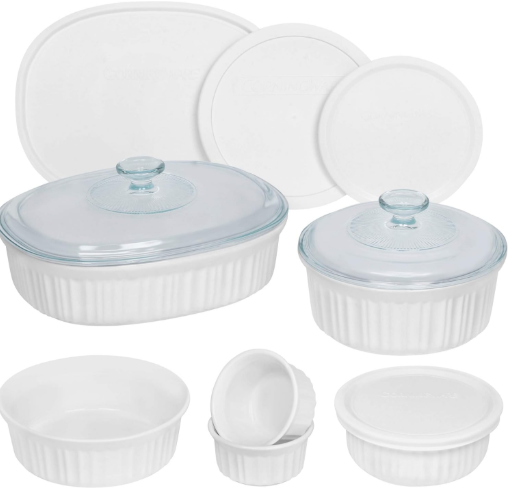
Description
This comprehensive set combines timeless stoneware bake dishes with accompanying lids—perfect for storage and reheating. Durable French-white aesthetic suits any kitchen.
Key Features
- Includes multiple sizes with matching lids
- Chip- and crack-resistant stoneware
- Safe for oven, microwave, fridge, freezer, and dishwasher
- Stackable for efficient storage
Pros
- Versatile uses across cooking, serving, and storing
- Lids reduce cleanup and can go directly into the oven
- Built-in thermal shock protection
- Excellent user reviews (~4.6⭐, thousands of ratings)
Cons
- Bulky when stored fully assembled
- Lids are stoneware—not airtight plastic
Recommendation
Best for those seeking a complete baking and storage solution without mixing materials.
3. DOWAN 9×13-Inch Ceramic Baking Dish
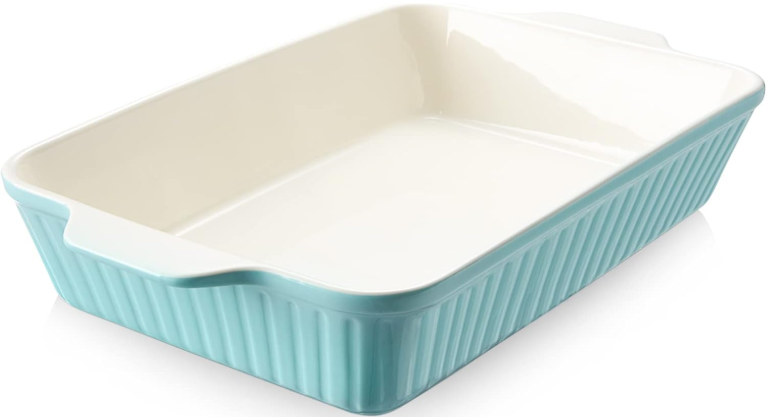
Description
A sturdy and affordable rectangular casserole dish with side handles, ideal for large meals like lasagna, roasts, and deep-baked dishes.
Key Features
- 4.2 qt capacity with easy-grip handles
- Durable ceramic, oven- and dishwasher-safe
- Generous nonstick glaze
Pros
- Highly rated (4.8⭐ from over 3,000 reviews)
- Affordable (around $30)
- Large capacity and excellent value
Cons
- Limited color options—mostly white
- May stain over time if not properly cared for
Recommendation
Perfect for family dinners and day-to-day baking where size and value are top priorities.
4. Le Creuset Heritage Stoneware 3‑Piece Rectangular Dish Set
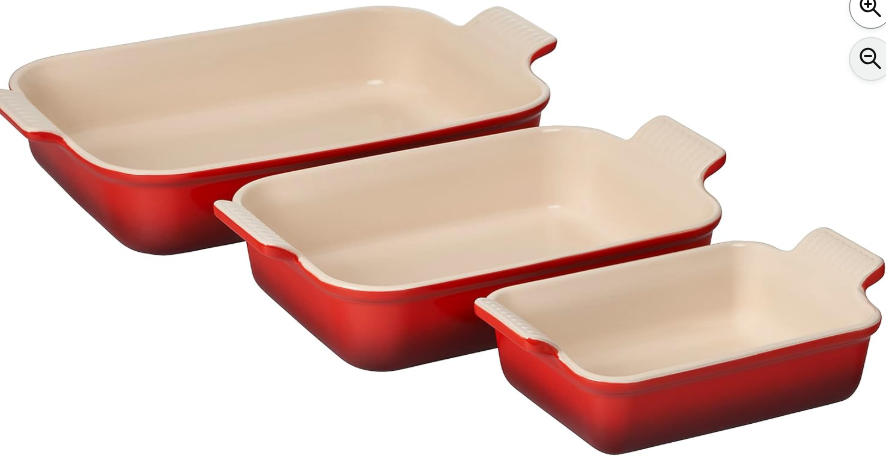
Description
Premium stoneware set combining classic design, panache, and serious cooking performance. Each piece features Le Creuset’s renowned craftsmanship and vibrant colors.
Key Features
- Dimensions: 12.5″ (4 qt), 10″ (2.5 qt), and 7.5″ (1.1 qt)
- Superior heat distribution and retention
- Chip-, stain-, and scratch-resistant glaze
- Compatible with oven, microwave, freezer, and dishwasher
Pros
- Elegant presentation straight to table
- Durable glaze does not absorb flavors or odors
- Color variety perfect for thoughtful gifting or matching kitchen décor
Cons
- Higher price point as premium stoneware
- Heavier weight may be cumbersome for some users
Recommendation
For those investing in heirloom-quality, stylish bakeware that excels in performance and aesthetics.
5. Staub Ceramic Rectangular Baking Dish
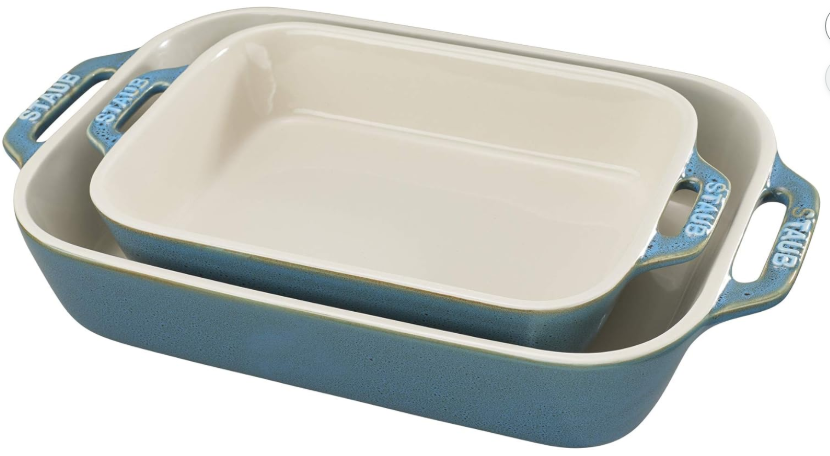
Description
From a brand celebrated for premium enameled cookware, this 9.8 × 14 × 3″ stoneware baker is Heat-resistant, durable, and praised for its consistent results.
Key Features
- Oven-safe up to 572°F, freezer- and dishwasher-safe
- Exceptional thermal shock resistance
- Classic French blue with pre-browned interiors
Pros
- Regarded as “best overall” by Food & Wine testers
- Great heat retention for browning and baking
- Large capacity, ideal for family meals
Cons
- Slightly more expensive than standard bakeware
- Lacks lids
Recommendation
The top choice for home cooks seeking professional-grade ceramic performance and durability.
6. Great Jones “Hot Dish” 4‑Quart Ceramic Casserole
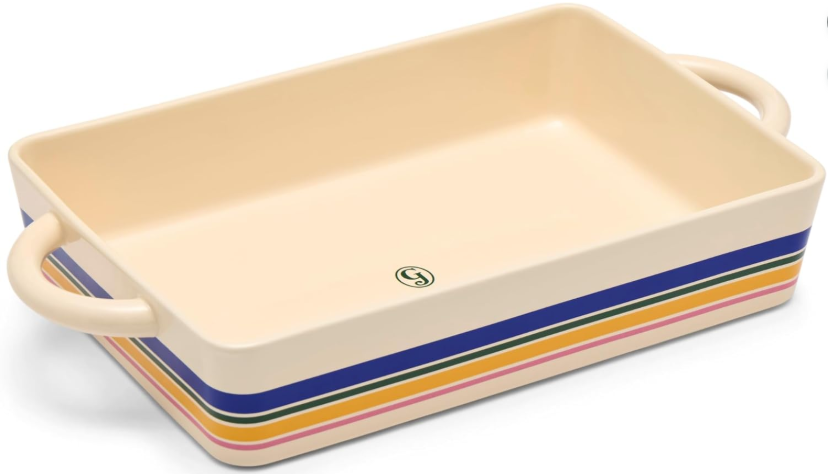
Description
This stylish, 4 qt casserole dish features a scalloped exterior, generous loop handles, and vibrant colors—designed to go from fridge to oven to table.
Key Features
- Holds 4 quarts; oven-safe to 500°F; freezer and microwave friendly
- Dishwasher-safe and broiler-safe (short bursts)
- Large looped handles and sleek silicone lid (sold separately)
Pros
- Fun, modern design adds flair to your dinner table
- Tested for excellent lasagna baking results
- Functional and photogenic
Cons
- Prone to scratching—avoid metal utensils
- Lid often requires additional purchase
Recommendation
Ideal for hosts wanting dramatic presentation paired with dependable baking performance.
✅ Summary Table
| Product | Best For | Highlight |
|---|---|---|
| MALACASA Set | Everyday baking & serving | Multi-size & versatile |
| CorningWare Set | Baking + storage solutions | Lids included |
| DOWAN 9×13 Dish | Large family meals | Affordable & spacious |
| Le Creuset Heritage | Premium performance | Colorful, durable stoneware |
| Staub Baker | Professional home cook | Exceptional heat retention |
| Great Jones Hot Dish | Stylish hosting | Unique design, functional |
By weighing your priorities—be it style, size, thermal performance, or price—you’ll be well-equipped to choose the best ceramic bakeware that fits your kitchen and culinary needs.
How to Use Ceramic Bakeware Properly
Ceramic bakeware offers reliable heat distribution and a beautiful presentation, but to get the most out of it—and keep it in great shape—it’s essential to use it correctly. Here’s how to use ceramic bakeware effectively for baking, roasting, and serving:
✅ How to Use Ceramic Bakeware
1. Preheat the Oven First
Always preheat your oven before placing ceramic bakeware inside. Sudden temperature changes can cause thermal shock and potentially crack the dish.
Tip: Let refrigerated ceramic dishes come to room temperature before baking.
2. Apply a Light Layer of Oil or Butter
Even though most ceramic bakeware is naturally nonstick, greasing the surface with oil, butter, or cooking spray will:
- Help prevent food from sticking
- Make cleanup easier
- Maintain the integrity of the glaze
3. Avoid Drastic Temperature Changes
Ceramic is sensitive to thermal shock. Never:
- Transfer a hot dish directly into cold water
- Move ceramic from freezer to a hot oven without thawing
Let ceramic cool or warm up gradually to avoid cracks.
4. Use Oven Mitts or Silicone Holders
Even if the bakeware has integrated handles, the entire ceramic dish gets hot. Always use protection when removing it from the oven.
5. Allow to Cool Before Washing
After use, let the ceramic cool naturally. Placing a hot ceramic dish into cold water can:
- Crack the ceramic
- Weaken its structure over time
6. Clean Gently
- Use soft sponges and mild soap
- Avoid abrasive scrubbers, steel wool, or scouring powders
- If food is stuck, soak the dish in warm water for 15–30 minutes before cleaning
7. Store with Care
- Stack ceramic dishes with soft padding (like a dish towel) between them to prevent chipping
- Store lids (if ceramic) separately or with protective liners
⚠️ Caution When Using Ceramic Bakeware
⚠️ Don’t Use on Direct Heat or Stovetop
Ceramic bakeware is meant for ovens only. Never use it on a gas burner, electric coil, induction plate, or open flame.
⚠️ Check Oven-Safe Temperature Limits
Each brand has its own maximum safe temperature (typically 450°F–572°F). Exceeding this limit can lead to cracking or glaze damage.
⚠️ Don’t Cut Food Inside the Dish
Using knives or sharp tools inside the bakeware can:
- Scratch or chip the glazed surface
- Shorten its lifespan
Always transfer food to a cutting board before slicing.
⚠️ Avoid Sudden Freezer-to-Oven Transfers
Unless explicitly labeled thermal shock-resistant, don’t place frozen ceramic dishes directly into a hot oven. Thaw them in the fridge or on the counter first.
⚠️ Inspect for Chips or Cracks Before Use
If your dish has visible chips, cracks, or crazing in the glaze, retire it from oven use. Damaged ceramic can break during baking or leach materials into food.
⚠️ Use Safe Utensils
Stick to wooden, silicone, or plastic utensils. Metal tools can chip or scratch the surface.
⚠️ Handle With Two Hands
Ceramic is heavier than metal. Use two hands and support from the bottom when moving large or hot dishes to avoid accidents.
Using ceramic bakeware properly ensures it remains both beautiful and functional for years. When treated with care, ceramic dishes can serve as both reliable cooking tools and elegant tableware—all while promoting healthier, even baking.
Frequently Asked Questions (FAQs) About the Best Ceramic Bakeware
1. Is ceramic bakeware better than glass or metal?
Ceramic bakeware offers better heat retention and more even cooking than glass or metal. While metal pans heat quickly and are great for browning, ceramic is ideal for moist, slow baking, such as casseroles and lasagna. It’s also non-reactive and safe for acidic dishes like tomato-based recipes.
2. Can ceramic bakeware go in the oven and microwave?
Yes, most high-quality ceramic bakeware is oven- and microwave-safe, but always check the manufacturer’s label. Make sure you follow the temperature limit—typically up to 450°F or higher—and never expose it to sudden temperature changes.
3. Is it dishwasher-safe?
Yes, many ceramic dishes are labeled dishwasher-safe, though handwashing is recommended to prolong the life of the glaze and prevent damage from abrasive detergents.
4. Does ceramic bakeware need to be greased?
Although ceramic is naturally nonstick, it’s always a good idea to lightly grease or oil the surface before baking. This ensures easier food release and helps maintain the integrity of the glazed finish.
5. What should I avoid when using ceramic bakeware?
Avoid:
- Thermal shock (placing hot dishes on cold surfaces or vice versa)
- Metal utensils, which can scratch the glaze
- Stovetops or open flames, as ceramic is oven-safe only
- Using it with deep cracks or chips, as it could break during baking
6. Does ceramic bakeware stain easily?
Ceramic can stain over time—especially white or light-colored glazes. Foods like tomato sauce or oil can leave marks if not cleaned promptly. Soaking and baking soda paste can help remove stains without harming the glaze.
7. Can I broil food in ceramic bakeware?
Some high-end ceramic brands are broiler-safe for short periods, but many are not. Check the product specs—if unsure, avoid using under direct flame or extremely high heat to prevent cracking.
8. How do I store ceramic bakeware safely?
To prevent chipping:
- Stack dishes with soft liners or dish towels between them
- Avoid overloading your cabinet shelves
- Store lids separately, especially if they’re ceramic or glass
Conclusion: Elevate Your Baking Experience with the Best Ceramic Bakeware
Ceramic bakeware isn’t just a visually stunning addition to your kitchen—it’s a functional, versatile tool that can help you cook healthier, tastier meals with ease. From even heat distribution to chemical-free surfaces, ceramic dishes are perfect for casseroles, roasts, cobblers, and more.
Whether you’re a casual home baker or a serious chef, the best ceramic bakeware offers durability, style, and performance that lasts for years—when properly cared for. Brands like Le Creuset, Staub, and CorningWare deliver on both form and function, while options like MALACASA and DOWAN provide affordability and everyday reliability.
With the right knowledge and care, your ceramic bakeware will serve as a trustworthy partner in the kitchen—from oven to table, and beyond.